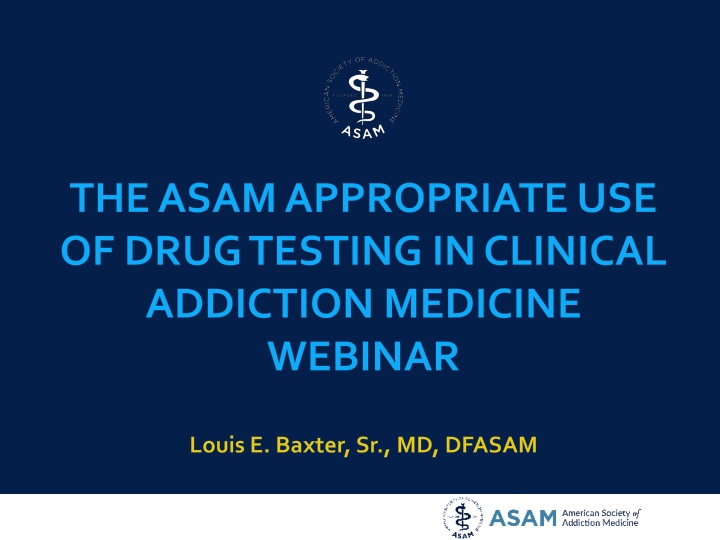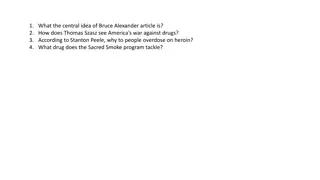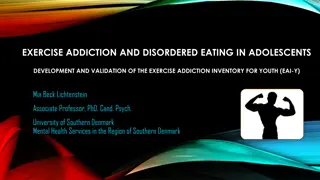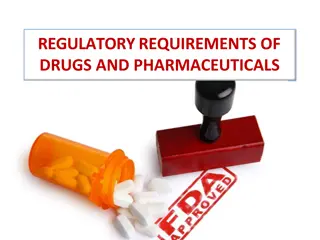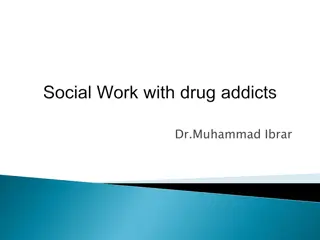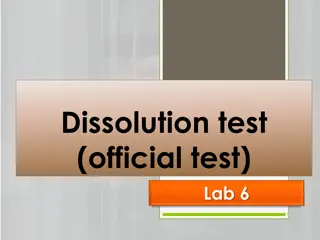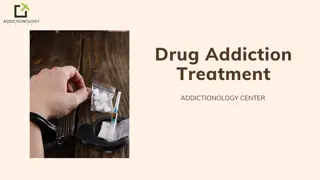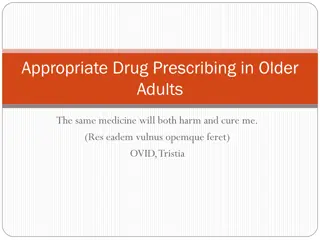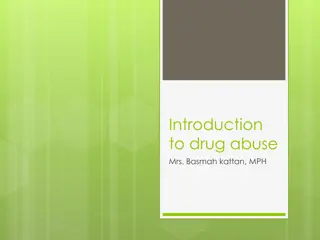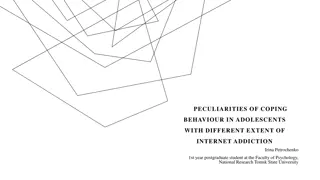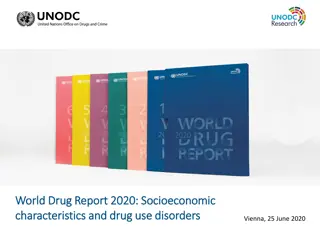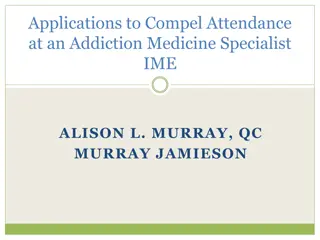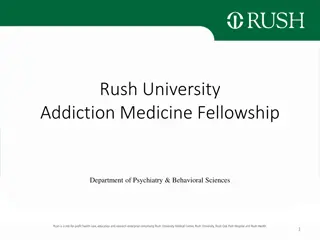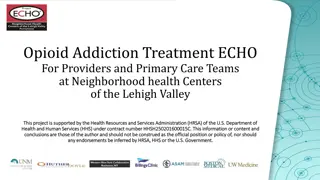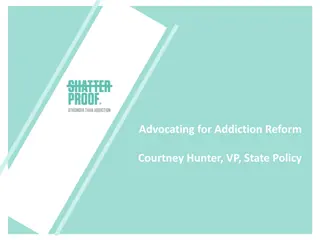Appropriate Use of Drug Testing in Addiction Medicine Webinar
This webinar discusses the importance of guidance on utilizing drug testing in clinical settings to aid in the identification, treatment, and support of patients with addictions. It addresses the lack of understanding among clinicians regarding methodological limitations, interpretation, and application of drug test results. Drug testing is recognized as a valuable technology for supporting recovery, highlighting the need for proper guidance and decision-making protocols in addiction medicine.
Download Presentation

Please find below an Image/Link to download the presentation.
The content on the website is provided AS IS for your information and personal use only. It may not be sold, licensed, or shared on other websites without obtaining consent from the author.If you encounter any issues during the download, it is possible that the publisher has removed the file from their server.
You are allowed to download the files provided on this website for personal or commercial use, subject to the condition that they are used lawfully. All files are the property of their respective owners.
The content on the website is provided AS IS for your information and personal use only. It may not be sold, licensed, or shared on other websites without obtaining consent from the author.
E N D
Presentation Transcript
THE ASAM APPROPRIATE USE OF DRUG TESTING IN CLINICAL ADDICTION MEDICINE WEBINAR Louis E. Baxter, Sr., MD, DFASAM
The ASAM Appropriate Use of Drug Testing in Clinical Addiction Medicine Webinar July 19, 2017 Louis E. Baxter, Sr., MD, DFASAM No disclosures
PRESENTATION OUTLINE 1. Why Do We Need This Consenus Document? 2. Context 3. Document Development 4. How to Use The Document 5. Principles of Drug Testing 6. Process of Drug Testing 7. Biological Matrices 8. Settings 9. Special Populations 10. Common Clinical Questions 11. Additional Information About Drug Testing
WHY DO WE NEED THIS CONSENSUS DOCUMENT?
Until now, there has been no specific guidance about how to effectively utilize drug testing in clinical settings to help identify, treat, and support the recovery of patients with addictions.
Clinicians needguidance. Currently, there is a lack of understanding of methodological limitations, interpretation, and application of drug test results among clinicians.
Clinical decisions related to drug tests are made every day. Even in the context of limited information about how best to apply this tool, providers and payers use it to make decisions about what kind of care patients should and do receive.
Drug testing can be a powerful technology for supporting recovery.
Historically, drug testing in addiction treatment has been wielded as a tool for control and punishment.
There has been a tug-of-war between fraudulent practices and restrictive insurance policies. Examples of Practices Examples of Policies Testing for an arbitrary, large number of drugs Testing with unnecessary frequency Using expensive confirmatory test methods on every sample Arbitrary restrictions on the frequency of drug tests Inability to order more than one test in a day Refusal to reimburse for more accurate drug testing methods
New drugs, drug use patterns, and drug testing technology have made clinical decision-making more complicated. Synthetic Drugs Cathinones Synthetic cannabinoids Synthetic opioids Patterns Rx drug misuse Polydrug use Opioids Drug Testing Technology Biological matrices Point-of-Care Tests Sophisticated lab tests
ASAM has worked for a number of years on this issue. However, ASAM has not previously released specific clinical guidance about appropriate drug testing practices.
The 2013 White Paper introduced the concept of smarter drug testing. Some elements of smarter drug testing Increased use of random drug testing Using other matrices in addition to urine Testing for specific drugs based on the individual and his/her community, instead of the same test panel for every patient Better collection strategies to avoid sample tampering Careful consideration of financial cost balanced against value and medical necessity This consensus document is a step to help providers engage in smarter drug testing.
ASAMs Quality Improvement Council (QIC) was the oversight committee for the development of the document. Other participants included: Institute for Research, Education and Training in Addictions Provided research and technical assistance Multidisciplinary Expert Panel Rated appropriateness of clinical practices Addiction Providers, Other Experts, Community Members Submitted comments through external review
The document was developed using a method based on the RAND/UCLA Appropriateness Method. Summary of Methodology 1 2 3 4 1. Literature review produces hypothetical clinical statements 2. Expert panelists individually rate statements appropriateness 3. Expert panelists meet face-to-face to discuss disagreements 4. Expert panelists re-rate statements Note: Expert panelists considered both empirical evidence and clinical experience when rating appropriateness statements.
Expert Panel included: Variety of specialties Allopathic and osteopathic Range of practice settings A multidisciplinary panel is recommended as part of the RAND/UCLA Appropriateness Method.
Expert Panel Members (in alphabetical order) Louis Baxter, MD, DFASAM Lawrence Brown, MD, MPH, DFASAM Matthew Hurford, MD, Expert Panel Moderator William Jacobs, MD Kurt Kleinschmidt, MD Marla Kushner, DO, FASAM Lewis Nelson, MD Michael Sprintz, DO, FASAM Mishka Terplan, MD, MPH, FASAM Elizabeth Warner, MD Timothy Wiegand, MD, FACMT, FAACT, FASAM
External reviewers included representatives from: American Academy of Pediatrics American Association for the Treatment of Opioid Dependence American College of Medical Toxicology American Congress of Obstetricians and Gynecologists National Association of Drug Court Professionals Substance Abuse and Mental Health Services Administration and many more organizations.
The primary audience for the document are providers who utilize drug testing in clinical settings. Providers are encouraged to utilize this consensus document to improve their quality of care, recognizing that it will be necessary to seek supplemental information when questions arise that this document does not comprehensively address. Healthcare administrators in residential, outpatient and other settings should reference this document as a guide for appropriate practice related to drug testing. This document may inform policy decisions related to establishing or improving a drug testing program in a variety of clinical settings.
Payers may use the document as a reference, but it is not designed to translate directly to payer policies. It would be inappropriate to translate the statement that during the initial phase of treatment, drug testing should be at least weekly into a payer policy that will not reimburse drug tests that are more frequent than weekly.
Key principle: Providers should understand that drug tests are designed to measure whether a particular substance has been used within a particular window of time.
Drug test results cannot Prove that substance use has not occurred Identify every possible substance that may have been used Rule out an SUD Diagnose an SUD
Other principles of drug testing: Combined with a patient's self-report Used as a therapeutic tool Performed at intake to assist in a patient's initial assessment and treatment planning Used to monitor recent substance use in all addiction treatment settings Used to monitor the effectiveness of a patient s treatment plan
Presumptive and Definitive Tests Technology Immunoassay Various chromatography and mass spectrometry techniques Capability Sensitivity Specificity Common model Screen with immunoassays Confirm with a more specific test to rule out false-positives
Presumptive Tests Should be routine Used when it is a priority to have more immediate (although less accurate results) Not always necessary to use a confirmatory test if patient confirms that he or she used a substance detected by a presumptive test
Definitive Tests Whenever a provider wants to: Detect specific substances not targeted by presumptive tests Quantify levels of the substance present Refine the accuracy of the results When the results inform clinical decisions with major clinical or non- clinical implications for the patient If a patient disputes the findings of a presumptive test Consider if presumptive test results are negative, but the patient exhibits signs of relapse
Attach a meaningful therapeutic response to test results, both positive and negative, and deliver it to patients as quickly as possible. Positive presumptive test results Speak with the patient Review all medications, herbal products, foods, and other potential causes of positive results Seek definitive testing if the patient denies substance use Positive definitive test result Consider intensifying treatment or adding adjunctive treatments Suspected inaccurate results Consider repeating the test, changing the test method, changing/adding to the test panel, adding specimen validity testing, or using a different matrix
Frequency of testing should be dictated by patient acuity and level of care. Frequency Initial phase of treatment: at least weekly Stable in treatment: at least monthly (with consideration for less frequent testing) Randomness When possible, testing should occur on a random schedule A random-interval schedule is preferable to a fixed-interval schedule
Using Various Matrices Urine, blood, exhaled breath, oral fluid (saliva), sweat and hair Smarter drug testing can mean using more than one matrix Important to understand the advantages and disadvantages of each matrix
Matrix Considerations Window of detection Time to obtain results (availability of POCT) Ease of collection (need for trained personnel, collection facilities) Invasiveness/unpleasantness of collection Availability of the sample (e.g., renal health, shy bladder, baldness, dry mouth) Susceptibility of the sample to tampering
Information about matrices windows of detection and utility in addiction treatment
Urine Most well-established and well-supported matrix Most prone to tampering
Oral Fluid Appropriate for presumptive testing, but does not have nearly such an extensive body of research behind it as urine Shorter window of detection than urine (12-48 hours for most substances) Advantages include: Unobtrusively collected Does not require the same staff and bathroom facility resources So far, does not suffer from the same sample tampering problems that urine has
The ASAM Criteria describes the continuum of addiction services using five broad levels of care.
Very little research has examined optimal drug testing practices specific to ASAM levels of care.
Levels of Care Outpatient: opportunity for substance use is greater Residential: importance of a drug-free therapeutic environment
Opioid Treatment Services Purposes include: Detecting substance use Monitoring medication adherence Monitoring possible diversion Consider increasing drug testing frequency during tapering and in the period after tapering Providers should understand metabolic pathways of commonly prescribed opioids
Opioid Treatment Programs Eight times per year should be a minimum Unexpected test results can lead to discontinuation or reduction of take home doses of medication
Office-Based Opioid Treatment Frequency should be at least monthly, unless otherwise clinically indicated. Patients who are stable in their recovery may require less frequent testing. Frequent office visits, Prescription Monitoring Programs, observed dosing, and medication counts can also help address diversion
Recovery Residences Weekly random drug testing is appropriate If expelled, patients should be able to continue an ongoing therapeutic relationship with outpatient addiction treatment provider(s)
Adolescents Document addresses general healthcare settings Drug testing can be used for early identification of substance use Drug testing can be used to monitor adolescents in addiction treatment or recovery from an SUD Providers should not encourage the use of home drug testing Testing without consent is not appropriate, except in emergency situations (e.g., accidents, suicide attempts, seizures)
